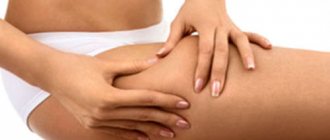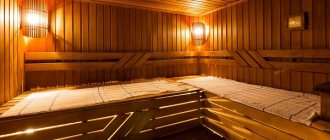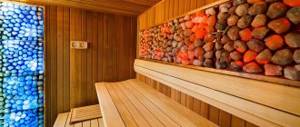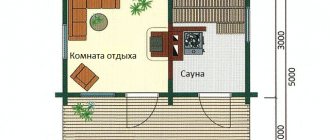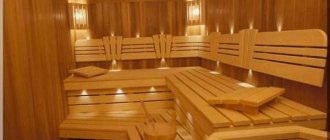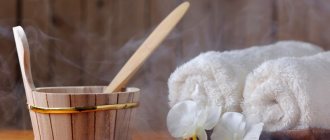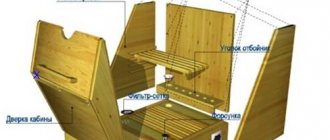Hello! Today we'll talk about the bathhouse. Do you like steaming in a sauna? I love it very much. When I lived in Donbass, there was a time when I went there consistently once a week for 4 whole years. At that time I didn’t get sick at all with colds and other nonsense.
Warm up in the steam room, then jump into the ice pool - it will be an amazing sensation, especially in winter and very useful. Well, what if you just worked out in the gym? Interest Ask. Let's talk about this now.
Many sports clubs and fitness centers offer not only well-equipped gyms, but also other areas, such as a fitness bar where you can rejuvenate with a protein shake or a sauna. There is an eternal debate about the latter between doctors and trainers, and there is still no clear opinion whether a sauna after a workout is useful or not.
Let's try to weigh the pros and cons of this very pleasant procedure for athletes after physical activity.
Types of saunas
Before we begin discussing the effect of a sauna on the body, we need to highlight its main types:
DRY SAUNA.
The main feature is maximum hot air up to 90-110 degrees, with minimum humidity below 15%. Dry steam is used for heating. The main representative is the Finnish sauna.
WET SAUNA.
It differs in air temperature of 75-90 degrees and high humidity. They are heated by pouring water over hot stones and also use aromatic oils, honey and cosmetics. After steaming, a cold pool is provided. A very invigorating and tonic procedure. Popular representatives are Russian and Turkish baths.
INFRARED SAUNA.
Quite a new invention of mankind. It is a small wooden room heated using infrared rays. It is characterized by a lower temperature, up to 40-50 degrees, so it is easier to tolerate and puts less strain on the heart.
The main feature is that the sauna warms up the body, and not the room itself. What are the benefits of an infrared sauna? With the help of her visit, you can relax tired muscles after a grueling workout and lose extra pounds. The rays also penetrate up to 4 cm under the skin, allowing you to get rid of even the last stage of cellulite and other skin diseases. The best option for athletes.
A little about the infrared sauna
Today, the infrared sauna is gaining popularity. This procedure is used both on the day of training and as a separate full-fledged service in various beauty salons.
An infrared sauna differs from a regular sauna in that it helps warm up the human body from the inside. This means that the body is renewed at the tissue level. The skin becomes firm and elastic, and excess fluid is completely eliminated from the body.
Which sauna to choose is up to each person to decide for themselves. Weigh the pros and cons before you decide to introduce your body into a kind of stressful situation.
What are the benefits of a sauna after a workout?
- A sauna immediately after a workout can be an excellent final step, helping to relieve physical and emotional stress and fatigue. Scientists say that while staying in the steam room, joy hormones are actively released - endorphins, which are responsible for raising your mood and feeling of lightness.
- The sauna perfectly detoxifies the body, removes excess fluid, toxins, decay products and other harmful substances. This is very important for athletes who constantly take sports nutrition and engage in heavy activities.
- Sauna is the best assistant for losing weight. Staying in a steam room burns up to 200 calories, and in an infrared room this figure reaches 800 calories. This is simply an amazing result for such a relaxing procedure, without physical effort.
- A special place is occupied by the benefits of a sauna after training for women struggling with cellulite. Many people note that after a steam room, the skin becomes more elastic, smooth and even. Also, the sauna has a very beneficial effect on the condition of the skin of the whole body, removes dead skin cells, fights inflammation, various rashes, opens and cleanses pores.
- Under the influence of high temperatures, residual lactic acid is removed from the muscles and the level of the hormone cortisol decreases. These are two enemies of the athlete's muscles, destroying them. Due to lactic acid, a person feels pain in the muscles after exercise, and cortisol gives them a feeling of heaviness and congestion. After visiting the sauna, muscles relax and recover faster.
- The sauna helps speed up metabolism and blood circulation throughout our body, warms up all ligaments and joints.
- The neuromuscular connection improves, that is, the muscles become stronger connected to our brain, and this is very cool.
- And finally, the biggest bonus for bodybuilders is that under the influence of high temperatures the level of growth hormone production increases (2-3 times).
I would also like to note that according to the latest research into the influence of the sauna on bodybuilding results, a wet bath with low temperatures reduces muscle strength over the next 12 hours by 20%. A hot dry bath (with humidity no more than 20-30%) increases the strength indicators of small muscle groups by 10-20%.
Baths after training[edit | edit code]
Source: “Sports Medicine”
Author:
Ed. S.P. Mironova, 2013
Currently, there are Russian, Roman, Turkish (Arab), Irish and Finnish baths.
Russian bath
characterized by the fact that its space is filled with saturated water vapor, forming fog, with a temperature in the range of 40-45 °C (maximum 50 °C). The steam room is equipped with benches located at different heights, the choice of which depends on individual heat tolerance. Cooling is carried out in various ways: water, fresh air, snow.
Roman bath
heated by dry hot air. Its temperature in a warm room (tepidarium) reaches 40-45 °C, and in a laconicum (caldarium) - 60-70 °C. Hot air is supplied to the floor or through holes in the walls. Both rooms are equipped with wooden benches located at different heights. Cooling is carried out in pools with different water temperatures: in the alveus, which is equipped with steps along the perimeter, about 35 °C, in the piscina - about 12 °C.
Turkish bath
has rooms with air temperatures of 50 and 40 °C, and air humidity is regulated by heating water in boilers. Cooling is carried out in a special room by pouring water with a gradually decreasing temperature or while staying in a room at room temperature.
Irish baths
spread in medieval Europe thanks to the efforts of the Irish doctor Barter. This is a bath with low saturation of water vapor without the formation of fog, with a temperature in the steam room of about 50-55 °C. Cooling is carried out using a shower or dousing. By now, these baths have practically disappeared.
Finnish bath (sauna)
heated by hot air with temperatures reaching 100 °C and low relative humidity. The sauna is equipped with stepped benches at different heights, which achieves a temperature difference from 65 to 90 °C. Before finishing your stay in the steam room, the skin is quilted with brooms or other means to provide mechanical irritation. Cooling is done in air or water.
The modes of taking heat-air baths are discussed in table. 1-3.
Table 1. Regime of the first intake of heat-air baths
(total procedure duration 1.0-1.5 hours)
| Periods of taking the heat-air procedure and elements of its implementation | Place of execution of procedure elements | Ambient temperature and procedure duration |
| Adaptation period | ||
| Warm hygienic shower with soap | Shower room | 37-28 °C. 2-3 min |
| Drying. 1st weigh-in | Rest room | 22-25 °C. 2-3 min |
| Two entries with an interval of 10-15 minutes into the heat chamber | 1st Regiment | 50-60 °C. 5-6 minutes each |
| Rest and intercooling in air | Rest room or outdoor veranda | 22-25 °C. 15-20 min |
| Main warm-up period | ||
| 1st entry into the thermal chamber | 1st Regiment | 50-60 °C. 7-10 min |
| Cooling and outdoor recreation | Recreation room, in the warm season - an open climate area | 22-23 °C 15-20 min |
| 2nd entry into the thermal chamber | 1st Regiment | 50-60 °C. 10-15 min |
| Intermediate air cooling | Recreation room, in warm weather - an open climate area | 20-22 “S. 10-15 min |
| 3rd entry into the thermal chamber | 2nd regiment | No more than 80-80 °C. 5-7 min |
| Intercooling using water and air | Pool | 28-32*S.2-3 min |
| Rest and prism replacement fluids (200-300 ml) | Restroom | 15-20 min |
| 4th entry into the thermal chamber | 1st Regiment | 50-60 °C. 3-5 min |
| Period of perspiration and final cooling | ||
| Cooling off in the pool or shower | 28-32 °C. 2-3 min | |
| Cooling and sweating in the air, taking replacement fluids 150-200 ml). 2nd weigh-in | Restroom | 22-23 °C. 15-20 min |
Table 2. Regime of the second intake of heat-air baths
(total procedure duration 1.5-2.0 hours)
| Periods of taking the heat-air procedure and elements of its implementation | Place of execution of procedure elements | Ambient temperature and procedure duration |
| Adaptation period | ||
| Warm hygienic shower with soap | Shower room | 37-38°C. 3-5 min |
| Drying 1st weighing | Restroom | 22-23 °C 2-3 min |
| 1st entry into the thermal chamber | 1st Regiment | 50-60 °C. 7-15 mim |
| Rest and intercooling in air | Restroom | 22-25°C. 10-15 min |
| Intensive warm-up period | ||
| 2nd entry into the thermal chamber | 2nd regiment | 60-70 °C. 5-10 min |
| Intermediate air cooling. in the pool, under the shower | Restroom | 22-23°C, 10-15 minutes 28-30°C. 2-3 min |
| 3rd entry into the thermal chamber | 2nd regiment | 60-70 °C. 7-10 mime |
| Intermediate air cooling. sweating | Restroom | 22-23 °C. 15-20 min |
| Massage, hydromassage (1.0-1.5 atm) | Massage | 5-8 min |
| Ingestion of cooling and replacement fluids (200-400 ml) | Restroom | |
| 4th final entry into the heat chamber using light beating with a birch or other broom | 3rd regiment | 80-85°C. 7-10 min |
| Final cooling period | ||
| Partial or general hydromassage 1.0-1.5 atm) | Massage or bath for | 10 min |
| self-massage | hydromassage | 7-10 min |
| Cooling off in the pool | 14-18 °C. 1-2 min | |
| Showering in the shower | 26-28 °C. 1-2 min | |
| Air baths | Climatoplate | No more than 5-7 minutes |
| Cooling and sweating in the air, drinking drinks (200-300 MP). 2nd weigh-in | Restroom | 22-25 °C. 20-30 min |
Table 3. Mode three of taking heat-air baths
(total duration of the procedure is at least 2 hours)
| Periods of taking the heat-air procedure and elements of its implementation | Place of execution of procedure elements | Ambient temperature and procedure duration |
| Adaptation period | ||
| Warm hygienic shower with soap | Shower room | 38 °C. 3-5 min |
| Drying 1st weighing | Restroom | 22-23 °C 1-2 min |
| 1st entry into the thermal chamber | 1st Regiment | 50-60 °C. 7-10 min |
| Relaxation and cooling in the air | Restroom | 22-23 °C 10-15 min |
| 2nd entry into the thermal chamber | 1st Regiment | 50-80 °C. 7-10 mime |
| Relaxation and cooling in the air | Restroom | 22-23 °C. 10-15 min |
| Main warm-up period | ||
| 3rd entry into the thermal chamber | 2nd regiment | 60-70 °C. 7-10 min |
| Cooling in water | L/sh. pool | 38-30 °C 2-3 min |
| Outdoor recreation | Restroom | 22-23 °C. 10-15 min |
| 4th entry into thermal chambers/ | 2nd regiment | 60-70 °C. 7-10 min |
| Intermediate air cooling. intense sweating | Restroom | 22-23 °C 15-20 min |
| 5th entry into the thermal chamber | 2nd regiment | 60-70 °C. 7-10 min |
| Intercooling | Shower. pool | 20-16 ”C 2-3 in |
| Rest, sweat | Restroom | 22-23 °C. 10-15 min |
| 6th entry into the heat chamber/ (manual kneading of the skin) | 3rd regiment | 80-85 °C. 5-7 min |
| Intermediate cooling in cold and frosty air or wiping with snow | Open climate area | Up to -10 °C. 2-3 min |
| Hydromassage, cooling in the pool (open water) | Not lower than 10 °C. 1-2 min | |
| Relaxing in the air, drinking drinks (200-300 ml) | Restroom | 22-23 °C 16-20 min |
| 7th visit to the thermal chamber | 3rd regiment | 85-90 °C. 5-7 iii |
| Final cooling period | ||
| Cooling in water or outdoors | Pool Climate site | 16-18 °C 2-3 min -10 °C. 2-3 min |
| Cold shower | Shower room | Not higher than 10°C. 1-2min |
| 2nd weighing, air cooling, rest, drinking drinks 1200-300 mp) | Restroom | 22-23 °C. 20-30 min |
When using baths, the following rules must be strictly observed.
- Immediately after physical activity, the use of baths is contraindicated.
- If you steam in a sauna on the day of physical activity, then the duration of stay is 8-10 minutes, and for those who do not have such work - 10-12 minutes. In cases where physical activity is planned a day or more after the sauna, the optimal length of stay in it is 20-25 minutes. If the microclimatic conditions in the sauna differ from those indicated, then the length of stay in the bath should be changed accordingly. At first, it is enough for beginners to make one visit to the steam room for 4-6 minutes.
- The principles of gradualism and consistency should be strictly adhered to. In all cases of deterioration in health (feeling of excessive heat, difficulty breathing, feeling of weakness, dizziness), you must immediately go to the locker room. Otherwise, heat stroke or other serious problems are possible.
- At the end of the bath procedure, it is useful to take a contrast shower. Alternating warm water with cool water is refreshing and invigorating. Body temperature, activity of the cardiovascular and other body systems remain elevated after the bath. It is advisable to avoid sudden cooling. It is highly undesirable to drink cold drinks or be in a draft immediately after a bath. If possible, you need to relax in a warm room, lie down, wrapped in a sheet, drink a glass of tea with lemon.
- For maximum periods of stay in the sauna, you need to rest for 45-60 minutes, i.e. until the initial level of physiological functions is restored.
- To compensate for dehydration at the intermediate stages of staying in the heat chamber and after the end of the procedure, it is necessary to take mineralized liquid (salted tomato juice, slightly alkaline mineral waters, refreshing drinks, fruit juices, freshly brewed weak tea). The amount of fluid taken should approximately be 50-60% of lost body weight (the difference between the initial and final weighing).
On average, the relative loss of water in a person when taking heat-air baths is 1.8 liters.
Data regarding weight loss, changes in heart rate, respiratory rate, blood pressure and subjective sensations during and after the procedure should be recorded in the procedure book.
The harm of a sauna after a workout
You also need to pay attention to this point, since visiting a sauna is associated with certain inconveniences for athletes:
- The main argument against the sauna is its negative effect on muscle growth. This occurs due to a decrease in the amount of glycogen in the muscles, which in turn triggers catabolic processes in the body, and high temperature prevents the saturation of the muscles with oxygen and nutrients.
- Taking a sauna after a workout is also undesirable due to untimely eating, and as you know, after intense physical activity, athletes need to close the so-called “protein-carbohydrate window”, otherwise all the hard work will not give the desired results.
- There are not only pros and cons to excessive fluid loss in the steam room. Along with harmful elements, vital electrolytes leave the body, which disrupts our water-salt balance and results in mild dehydration.
- Under the influence of hot steam, blood vessels dilate, blood pressure rises and the heart rate increases. This is a huge burden on the cardiovascular system, which is already overloaded from exercise. After cardio training, the sauna is strictly prohibited, otherwise you can get serious health problems.
As you can see, there is no clear answer as to whether it is possible to steam after a workout; everyone decides for themselves the best option for themselves. In this matter, the main thing is not to go to extremes, but to follow some rules and recommendations on how to properly go to the sauna after training.
It would be a good idea to consult with your doctor or trainer, because each body is individual and can react differently.
What to wear to the sauna with friends. What to take with you to the sauna
When planning a visit to a bathhouse or sauna, you need to bring with you a whole set of bath accessories and attributes. In order not to overshadow such pleasant moments of pleasure in the steam room, it is better to think through everything before leaving and not miss the little things.
Today, good-quality public saunas have everything you need and are ready to provide their guests with a full range of bath accessories. But still, using your own things is both more pleasant and smarter in terms of compliance with hygiene standards.
So what should be in the kit of an avid bathhouse attendant?!
Broom
Well, what would a bathhouse be without a broom? If you want to get the most out of your visit to the bathhouse, you simply cannot do without it. Brooms come in birch, linden, oak, and eucalyptus. With their help, the benefits of the bath will be even greater. When whipped over the body with a broom, the muscles relax, the pores open and are cleaned even better. In addition, a pleasant aroma will be felt from the leaves in the steam room.
Mittens
If there are brooms, there should also be mittens. The steamer needs them to avoid injuring his hands and to protect them from calluses. Mittens should be made of natural fabrics, cotton or wool. You can’t do without them when you need to clean the stove or replace stones.
What to wear
If you visit a public bath or sauna, then the likelihood of contracting a fungus is very high. To prevent this, be sure to wear shoes in the bathhouse. Rubber slippers are best; they don't slip. Cloth slippers will quickly get wet, but plastic slippers can easily fall on a wet floor.
If you are in your own bathhouse and are sure that no infection threatens you, walking on a wooden floor barefoot is not only possible, but even useful.
cap
High temperatures can cause your scalp to overheat and make your hair dry. Therefore, visiting a bathhouse without a headdress is extremely risky. It is recommended to wear hats made of felt or wool. If you don’t have a special hat, you can wrap a towel around your head. You cannot enter the steam room with a wet hat or towel on your head, as this will increase the likelihood of getting heatstroke.
sheet
A cotton sheet in a bathhouse, especially in a public one, is needed in order to lay it on a shelf and lie or sit on it. Firstly, sitting on uncovered hot shelves is simply uncomfortable. And secondly, again the question of hygiene. In public saunas it is very easy to catch an infection and therefore it is simply impossible to do without bedding.
Towel
Of course, if we are talking about water procedures, there must be a towel. You can take two towels. They are needed to get your body wet after a shower. Before you start getting dressed, you need to thoroughly dry your body and hair with a dry towel.
Personal care products
After using the steam room, you should take a shower and wash your hair. And of course, for these purposes you will need soap, gel and shampoo. By the way, today there are many varieties of soap, including natural ones. It is best to give preference to him. Natural supplements will make your skin smoother and more elastic. Additionally, you can take with you a pumice stone, shaving accessories, a variety of washcloths and brushes, and other things that you are used to using.
Other means
In addition to standard procedures, representatives of the fair sex often like to pamper their bodies with peelings and scrubs. Everything here is up to your taste. But it’s better if scrubs or masks are made from natural products:
- clay,
ground coffee,
olive oil,
honey,
sour cream,
lemon juice.
All these ingredients have long been used as a powerful means to moisturize, cleanse and nourish the skin.
Aromas in the sauna
Staying in the sauna will be more pleasant if a pleasant aroma accompanies you throughout the entire session. To do this, take your favorite essential oils or herbal infusions with you.
- Chamomile, coltsfoot, and lavender will have a relaxing and calming effect.
Eucalyptus, fir, cedar will be useful for preventing the respiratory tract and treating colds.
Citrus, mint aromas, ylang-ylang will charge you with energy and good mood.
Food and drink
Today, many people, going to the sauna or bathhouse to unwind, stock up on food. But in practice, going to the steam room after a heavy lunch or dinner will not bring any benefit, and sometimes it can do harm.
Two hours before entering the bathhouse, it is better to refuse heavy food. It is recommended to take plenty of liquid with you - tea, herbal infusions or mineral water. It is better to take them in between steam rooms. This will speed up the sweating process and effectively cleanse the body of toxic harmful substances.
Tips for visiting the sauna
- Use the sauna only after moderate-intensity workouts lasting no more than 45 minutes.
- Don't go steaming after cardio exercise.
- The time of visiting the sauna is no more than 15-20 minutes.
- Wait at least 10-20 minutes after finishing your workout to restore your heart rhythm.
- Stay hydrated during, after, and while in the steam room and afterwards.
- Give preference to infrared saunas.
- Listen to your feelings and leave the sauna at the slightest discomfort.
It is impossible to deny the beneficial properties and effects of the sauna; if you can visit it during your free time from training, this will be preferable. If you want to take a sauna after training, follow the basic rules and do not overdo it.
That's basically the whole article. I think I managed to answer your question and now you are aware of whether you should steam your body after training or not. Let me know in the comments about this - I will be pleased. See you again, friends!
comments powered by HyperComments
PS Subscribe to blog updates,
so you don't miss anything!
I also invite you to my Instagram

